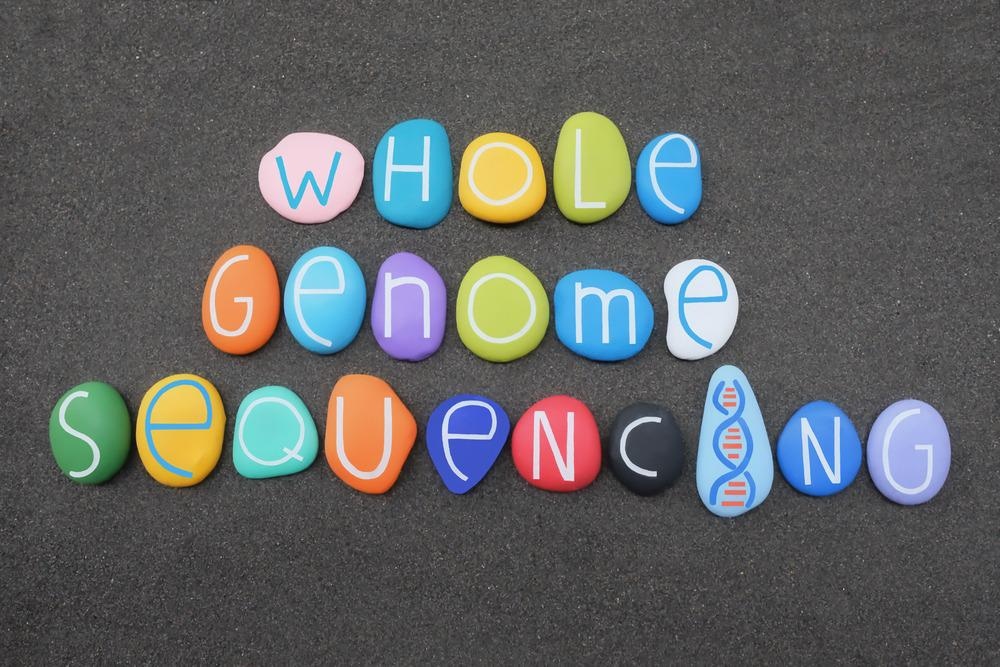Analysis of an individual’s genome through whole-genome sequencing (WGS), can reveal areas of DNA that vary from the ‘normal’. WGS utilizes DNA markers, such as single-nucleotide polymorphisms (SNPs), to determine an individual’s health, predispositions to disease, and clinical diagnoses.

Image Credit: yournameonstones/Shutterstock.com
Many human diseases have some genetic influence; an individual's genetic code can affect the disease phenotype and pathogenesis, whether directly or indirectly. With the human genome project complete, areas of variation associated with disease can be more easily identified through WGS. Mapping these variations and their associated phenotypes allows for individualized diagnosis and treatment.
How to sequence the entire genome
There are multiple technologies available to analyze the genome, all of which require the DNA in small 300 - 600bp fragments, depending on the sequencing platform being used. In contrast to their chain-terminating predecessor, next-generation sequencing (NGS) methods utilize a DNA library to allow rapid parallel sequencing. The library of DNA fragments is immobilized and amplified, then sequenced.
Oligonucleotide primers immobilized on a solid support can be developed with complementary base pairing to adaptors. These adaptors are ligated to the end of DNA fragments, to attach the fragments to the support. Metallic beads can be used as solid supports, with a coating of streptavidin to attach the biotin adaptors, ligated to the end of the DNA fragments. DNA that has attached to the solid support is replicated.
The clusters of identical DNA fragments are broken into single strands to be sequenced. A popular method uses Illumina sequencing technology. By giving each base a unique fluorescent label, it is possible to determine the order the bases are incorporated into the new DNA strand. The Illumina technology is able to produce a report of the whole genome from a human sample in less than 30 hours; identifying variations associated with disease and genes of interest by a TruSight Software Suite.
Genetic diagnosis
WGS is a well-utilized tool in oncology. In combination with the sequencing of RNA in cancer cells, WGS can provide detailed information about the molecular basis of an individual’s cancer; aiding in identifying cancer-causing genes and potential therapeutic targets. The Cancer Genome Atlas (TCGA) has helped to define cancer genomics and precision cancer medicine. Publishing a wealth of genomic data online, the TCGA program has a repository of ~24,000 genes and ~3,600,000 mutations to aid in diagnosis and treatment planning.
WGS also plays a vital role in the diagnosis of rare diseases. WGS can allow for rare diagnoses, with known genetic components, to be identified relatively quickly. In Sweden, they are implementing genome sequencing as a clinical routine for suspected rare genetic diseases; with a total of 3,532 genomes sequenced, according to a September 2020 survey. For children hospitalized with severe illnesses in America, WGS is available to discover a genetic diagnosis.
WGS in ‘healthy’ individuals
WGS in those without a clinical diagnosis could help identify areas of DNA associated with disease phenotypes and predispositions to disease. In turn, WGS can help to inform an individual’s health decisions, as well as their personalized prescriptions. Sequencing panels translate genetic code into information that can be applied to healthcare plans, identifying areas of DNA associated with a phenotype of interest. With the entire human genome sequenced, and elective genetic sequencing becoming more accessible, identifying variations in the genome to make informed lifestyle choices is becoming more available.
With every aspect of human health influenced by the genetic code, genetic variations give rise to unique health requirements. Photosensitivity syndromes are an extreme example of this. Due to defects in the pathway responsible for repairing DNA lesions caused by UV light, photosensitive individuals live with an extremely high risk of cancer; accommodating this genetic predisposition by avoiding light exposure.

Image Credit: SciePro/Shutterstock.com
Determining the health of a fetus with WGS
As we understand more about the genes responsible for various diseases, it is possible to make informed decisions in embryo selection during |IVF. With preconception genetic screening, embryos can be checked for selection of those that have not inherited a condition; or, it can help identify embryos with an enhanced chance of successful pregnancy. Non-invasive prenatal tests are also available to help parents better prepare for caring for a child with a genetic condition.
Much of the medical potential of WGS is limited by ethical and social concerns. The storage and use of an individual’s genomic data, as well as the potential to share and profit from their data, pose challenges to implementing WGS. In September 2020, the UK government announced plans to create a genomic health care system over the next 10 years. By establishing a shared standard for storage and access across all National Health Service (NHS) sites, a single data repository with patient privacy and confidentiality could be developed.
Sources:
- Jackson, C., (2019) et al. Trust and the ethical challenges in the use of whole-genome sequencing for tuberculosis surveillance: a qualitative study of stakeholder perspectives. BMC Med Ethics. doi.org/10.1186/s12910-019-0380-z
- Spivak, G., Hanawalt, P.C. (2015) Photosensitive human syndromes. Mutat Res. doi:10.1016/j.mrfmmm.2014.11.003
- Department of Health and Social Care. (2020) Genome UK: the future of healthcare. [Online] gov.UK. Available at: www.gov.uk/.../genome-uk-the-future-of-healthcare (Accessed on 15 October 2021).
- Yale Medicine. Whole Genome Sequencing. [Online] Yale Medicine. Available at: https://www.yalemedicine.org/conditions/whole-genome-sequencing (Accessed on 15 October 2021).
- National Cancer Institute. (2019) Outcomes & Impact of The Cancer Genome Atlas. [Online] National Cancer Institute. Available at: www.cancer.gov/.../history (Accessed on 15 October 2021).
- Illumina. Areas of Interest. [Online] Illumina. Available at: https://emea.illumina.com/areas-of-interest.html (Accessed on 15 October 2021).
- Soller, M.J., (2021) et al. Whole genome analysis for rare diagnoses provides great patient benefit. Läkartidningen.
- Hou, Y.C., et al. (2020) Precision medicine integrating whole-genome sequencing, comprehensive metabolomics, and advanced imaging. Proc Natl Acad Sci USA. doi:10.1073/pnas.1909378117
- Nones, K., et al. (2019) Whole-genome sequencing reveals clinically relevant insights into the aetiology of familial breast cancers. Ann Oncol. 30(7):1071-1079. doi:10.1093/annonc/mdz132
- Pillay, S., et al. (2020) Whole Genome Sequencing of SARS-CoV-2: Adapting Illumina Protocols for Quick and Accurate Outbreak Investigation during a Pandemic. Genes (Basel). doi:10.3390/genes11080949
Further Reading
Last Updated: Feb 24, 2022